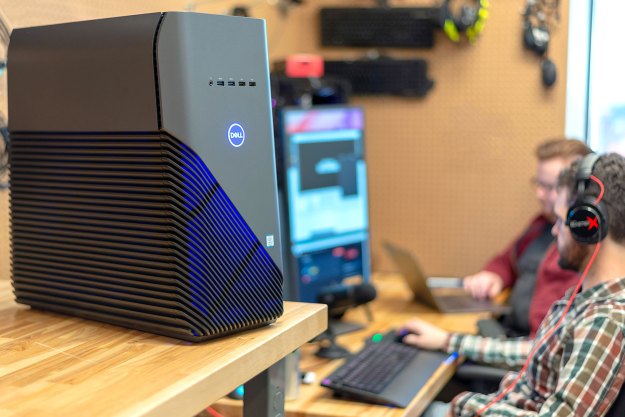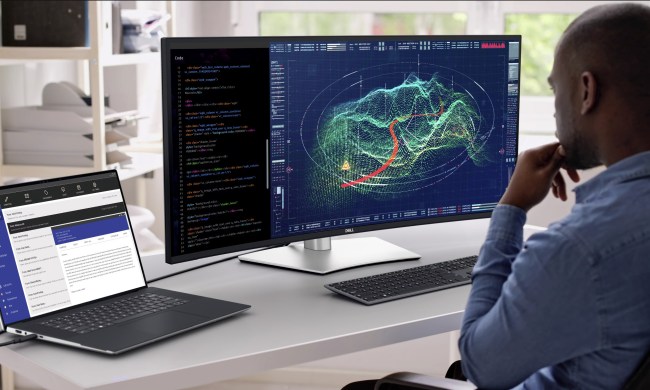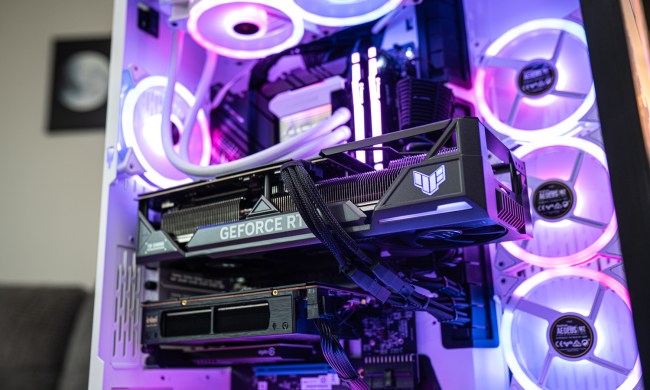
- Great gaming performance
- Handsome design
- Speedy 8th-gen processors
- Excellent overall value
- Mediocre storage options
- No USB-C in some configurations
Amidst the rollercoaster of skyrocketing GPU prices, there have always been cheap alternatives to building your own gaming PC. For the past couple of years, our favorite has been the Dell Inspiron 5675 Gaming Desktop, powered by AMD hardware. It performed well at a good value, starting at just $600.
Dell has refreshed the system with updated Intel and Nvidia components, including 8th-gen Core processors, and up to a GTX 1060 graphics card. Our review unit was the top-of-the-line configuration, which will cost you $1,100 for a Core i7-8700, 8GB of RAM, a 128GB SSD, and a 1TB hard drive.
While the price of desktop video cards remains inflated, Dell’s Inspiron 5680 is just affordable enough to make it a great alternative to building a PC from scratch.
Design
The Inspiron 5680 looks nearly identical to the 5675 — and that’s a good thing. It’s not overly flashy like many dedicated gaming systems, but the blue LED lighting is just enough to spice up the aesthetic. Shining through the open vents on the left side, it’s a classy reminder that the system is ready to game
We appreciate that Dell stuck with this more modest appearance rather than going the direction of the Asus G11DF, which looks distinctly like a cheap gaming desktop. The Inspiron 5680 is more confident in what it wants to be. If you want a little more edge, Dell offers an optional clear side panel to highlight the internals. That’ll set you back $50 bucks.
The custom-built chassis also feels sturdy, and the plastic panels have little flex in them. The gaps in between those panels are large, though, which makes it hard to keep the internals clean.
Two port options
The Inspiron 5680 comes in two primary port setups for each configuration – with optical drive, and without optical drive. Having an optical isn’t going to be a selling point for most, but for the few who are dedicated to DVDs and CDs, it’s a nice option to have. However, the optical drive version of the tower also has another perk. A front-facing USB-C port. It costs an extra $50, but it could be worth it to make your system both backward compatible and futureproof. That fifty bucks will also award you the clear side panel as part of a package deal.
It would have been nice to see one more HDMI port in case you want to hook up a monitor and VR headset simultaneously, but you can always use DisplayPort for that.
As for rear ports, you’ll find the standard array of offerings on all models — four USB-A 3.1, two USB-A 2.0, an Ethernet jack, three full-sized DisplayPorts, and an HDMI port. It would have been nice to see one more HDMI port in case you want to hook up a monitor and VR headset simultaneously, but you can always use DisplayPort for that as well. Otherwise, the system comes with a standard 802.11ac Wireless card, and support for Bluetooth 4.1.
Easy to upgrade, within limits
Like the exterior design, not much has changed on the inside of the Inspiron 5680. Removing a couple of screws opens access to the interior. Because of its relatively small size, the components are a bit cramped, though not as squished as something like the XPS 8930. You have a clear view of your

The
The primary stumbling block toward upgrading your GPU is the power supply. This tower comes with a 460-watt supply, nicely tucked into the bottom corner of the chassis out of the way. It can handle a GTX 1060 without issue, but a GTX 1070 or 1080 – or AMD Radeon RX Vega 64 – will likely be too much for it. In comparison, even the Acer Aspire GX Gaming Desktop offers a 500-watt supply, which provides a better base to power some better graphics cards.
Processor Performance
Intel’s 8th-gen CPUs are substantial jumps over the previous generation, and you can especially feel it with the Core i7-8700. We ran it through Geekbench and saw some impressive results, especially in multi-core performance. Taking advantage of the six cores and twelve threads, it landed a multi-core score of 19,642. In our testing, it’s only bested by Origin’s beastly gaming desktops using K-series chips. It’s no slouch in single-core performance, either.
We we ran the CPU through a more difficult task in the form of Handbrake, where we see how quickly a system can encode a 4K video. The Inspiron 5680 nailed a score of 3 minutes and 15 seconds, which is impressive, though it was surprisingly bested by the Core i7-8809G found in Intel’s Hades Canyon NUC.
In day-to-day performance, we found the Inspiron 5680 can handle productivity well, never hesitating or slowing down. Need to have 10 YouTube videos playing while streaming Spotify, multitasking with 25 Chrome tabs, and Photoshop open? This desktop will handle a ridiculous scenario like that just fine.
Storage Performance
While processor options are great across the different configurations, storage options are not quite as fleshed out. This is where Dell is cutting some costs — with a system this cheap, it must somewhere.
It would have been nice to see a 256GB SSD configuration as an option from Dell.
The $600 and $800 configurations come with 1TB of storage, but only in the form of a slow, hard disk drive. It delivered sad read and write scores of under 200 MB/s. The $950 and $1,100 models provide a secondary SDD, but it’s a SATA-connected drive with only 128GB of space. It achieves less than a fourth of the speeds of faster standards like PCIe, which is often used on modern laptops and higher-end desktops.
On the other hand, that would have added some cost to the overall price of the product — and some of the Inspiron 5680’s competitors, like the Acer Aspire GX desktop, doesn’t even include a solid state drive.
We’d like to see at least a 256GB SSD configuration at least listed as an option from Dell. You might not consider storage to be as important, but let’s paint a completely hypothetical situation for you. You’re trying to download a very large game like Battlefield 1 to test it out with a new game system you’re reviewing. Problem? It’s too big to fit on the provided 128GB SSD, so you must rely on that old hard disk drive. You find this out halfway through the install, of course, and must start all over again.
Game-ready for 3D and VR
The Inspiron 5680 is labeled as a “gaming desktop,” so it better be able to play. Don’t worry — it can! The system comes with either a GTX 1050 (with 2GB) at the $600 price point, or the GTX 1060 (with 3GB) starting at $800. Both are capable GPUs, though the 1060 will provide you with a significant increase in framerate. You also have the option of the AMD-powered system, which comes with either the AMD Radeon RX 560 or 570.

In 3DMark, you can see how well the GTX 1060 handles 3D rendering of all sorts. It blows 1050-based systems out of the water — and again, picking one up in a system for only $800 is a solid deal. That doesn’t just make it good for games — it can also handle high-resolution photo and video editing, as well as intensive 3D modeling software.
It even had some impressive results in VRMark, which tests how well a system can render in virtual reality. In the Orange Room test, the GTX 1060 exceeded requirements for powering Oculus Rift and HTC Vive VR headsets. Dell calls the system is “VR-ready,” and according to our benchmarks, it should be able to handle most VR experiences at solid framerates, though you may need to turn down a setting here or there.
As for games, you won’t be disappointed with performance. The GTX 1060 has nowhere near the power as something like a GTX 1080, but even at 1440p, most games are can be played at smooth framerates with the settings cranked.
We averaged 50 FPS in 1440p with settings on Epic in Fortnite, whereas bringing it down to High settings will pop it up to over 100 FPS. The same goes for other lighter fare like Rocket League, where it earned 132 FPS at highest graphics settings at 1440p. We couldn’t test it out in
But what about some more difficult games? Well — in Battlefield 1, the system effortlessly pushed out 87 FPS on Medium settings and a very solid 59 FPS to match on Ultra. The looked and felt fantastic. A similarly graphic-intensive game like Civilization VI produced a solid 62 FPS on Ultra in 1440p, and a better 107 FPS when bumped down to Medium.
We did manage to stump the Inspiron 5680 though. It was in Deus Ex: Mankind Divided at 1440p with the graphics on Ultra. At 26 FPS it wasn’t quite playable, though turning it down to 1080p solves that problem. The final word? Outside of the most graphic-intensive games, you should be able to play most modern games at respectable framerates, even at higher resolutions and graphics settings.
Our Take
The Inspiron 5680 is not a top-of-the-line gaming desktop, but if you need some respite from the high GPU prices on the market — or are just looking for an affordable
Are there any alternatives?
If you want to save a little cash and are willing to compromise some gaming performance, the AMD-based Inspiron 5675 isn’t a bad alternative. On the other hand, Dell’s XPS 8930 is similarly-priced with a stealthier, office-friendly design.
You can find solutions by other desktop manufacturers, like the Asus G11DF or Acer Aspire GX Gaming Desktop, but they often don’t give you as much bang for your buck. The upcoming HP Pavilion Gaming lineup offers a strong set of configurations, but it doesn’t offer a GTX 1060 for as little as $850.
How long will it last?
The Inspiron 5680 sets you up for future component swaps and upgrades well. The lack of USB-C on some configurations may come to bite you in the future.
Should you buy it?
Yes. It won’t satisfy people looking for a high-end system, but if you want to do some PC gaming on a budget, the Inspiron 5680 is for you.







